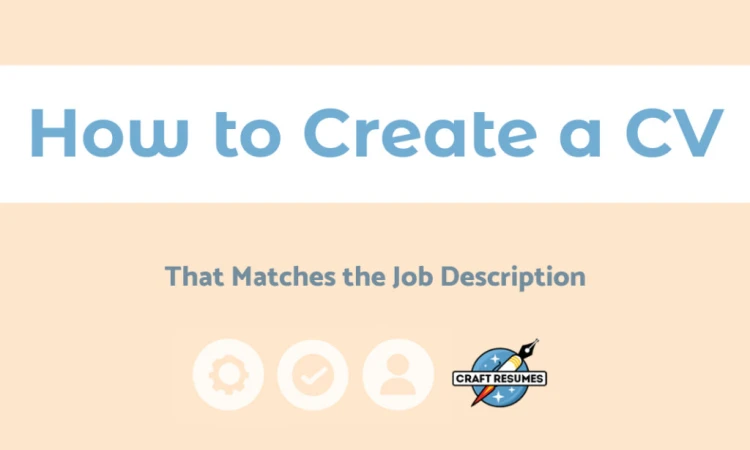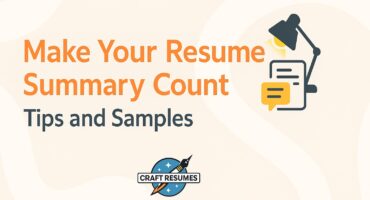
How to Create a CV That Matches the Job Description
Jul 10 2025
If you’re not sure how to make a CV for a job, you’re not alone. Learning how to make CV for job can significantly boost your chances of success. Many people get stuck figuring out what to include, how long it should be, or how to match it to a specific job description. A curriculum vitae is more than just a list of work experience—it’s a way to show employers your most relevant skills, education, and achievements in your job search.
In this guide, we’ll describe what goes into a good CV, provide tips on how to write each section, and explain how to make sure your CV fits what potential employers are looking for. We’ll also show you how to avoid common mistakes, follow a standard format, and use the right structure, so your CV is easy to read and works with online systems.
Why Some CVs Get Read and Others Don’t
When someone opens your curriculum vitae, they decide in seconds. They don’t read every word—they scan. One common mistake people make is trying to fit everything they’ve ever done onto one page. But more doesn’t mean better.
✅Here’s what helps your CV stand out right away:
- A simple layout with a clear font
- Your contact details are easy to spot at the top
- A short personal profile
- Clear bullet points under each job title that show results
- Skills and tools that directly match what’s in the job advert
Many people find writing their CV harder than expected. They’re not sure how to describe their responsibilities without sounding vague, or how to highlight real impact. That’s where CraftResumes can help with your career. Their team takes what you’ve already done—education, work experience, skills, publications, and more—and shapes it into a clear, readable CV that fits the position you’re applying for.
Should You Use a CV or a Resume?
Some employers use the words “curriculum vitae” and “resume” to mean the same thing. However, they are not the same. A CV lists your academic work, research, and education, especially in higher education. A resume only presents the elements of your work history and talents relevant to a certain employer. Here’s a simple way to compare qualifications and experiences:
| Feature | CV | Resume |
| Main Use | Academic, research, teaching roles | Business, tech, other non-academic jobs |
| Length | Often two pages or longer | 1 page (or 2 if needed) |
| Focus | Full overview: education, publications, conference presentations, research experience | Short version focused on relevant skills |
| Sections | Work experience, qualifications, academic work, professional memberships | Skills, job title, achievements |
Some employers say “CV” but want a resume, so it’s important to read the job description carefully. You’ll probably need to send a curriculum vitae if the role mentions research, publications, or academic work. But a resume is usually the right choice if the listing is short and focused on quick highlights. If you’re unsure how to decide or adjust your CV for a specific role, career consulting services can help you figure it out. Talking with someone who knows what hiring managers look for can save time and help you feel more confident about what you send.
Keep Your Curriculum Vitae Easy to Read
When someone looks at your curriculum vitae, they should immediately see the important details. Use a plain font like Arial or Calibri, size 10 to 12. Leave space between sections and keep margins around one inch, so the page isn’t too full. Don’t use tables or graphics—most hiring systems can’t read them. Save your file as a .docx unless the job description says to use something else.
Organize your CV using clear section titles like “Work Experience,” “Education,” and “Skills.” Write in bullet points instead of long blocks of text. List your jobs in reverse chronological order, with the newest one first. Ensure your job title, company name, and dates are easy to spot. Use the same format throughout the document so it looks clean and consistent.
The Main Parts Every CV Should Have
There are some key parts that every CV has to include that contain important information. Employers look at these first; thus it’s important to make them clear and easy to read:
- Contact details – Your name, phone number, email, and address
- Summary – A short paragraph that explains who you are and what you’re looking for
- Work experience – Listed in reverse chronological order, with your job title, company name, dates, and a few bullet points about what you did
- Education – Your degrees, school names, graduation years, and any relevant courses
- Skills – Focus on tools, programs, or strengths that match the job description
Should You Add a Personal Profile?
If you’re applying for your first job, changing fields, or don’t have much recent work experience, this is a good way to explain your aim. Keep it brief—two or three lines is enough. Say what kind of job you’re looking for and what you’ve done before, and mention some skills matching the job description. Focus on what you want to do next, not everything you’ve done before. Example:
- “Recent business graduate with customer service and project support experience. Looking for an entry-level admin role. Comfortable with Excel, scheduling tools, and working in teams.”
- “Former retail assistant now training in IT support. Looking to move into a junior tech role. Good at problem-solving, communication, and learning new tools quickly.”
Show Real Results in Work Experience
The work experience section of your curriculum vitae should do more than list what you were responsible for. It should show what you did and what results you achieved. Use clear numbers, tools, and short examples to make your work easier to understand. Start each job with your title, company, location, and dates, followed by bullet points highlighting outcomes. Keep the format consistent across all roles, and focus on what matches the job description. In more detailed fields, especially healthcare, this can be harder to organize clearly. That’s where medical resume writing services can help. They take all that specific experience—clinical tasks, systems used, patient volume—and turn it into content that’s clear, structured, and ready for review. Here’s a comparison:
| Basic Task | Clear Result |
| Answered phones | Handled 40+ calls a day, reduced wait time by 20% |
| Responsible for social media | Increased Instagram followers by 2,000 in 3 months |
| Helped customers | Assisted 30 customers daily, kept satisfaction score above 90% |
| Updated records | Checked and entered 200+ records weekly with 100% accuracy |
Education and Skills That Fit the Role
Your education section should list your degrees, school names, and graduation years. Start with the most recent and go backward. If you’re still studying, just write your expected finish date. You can leave out dates if the degree is older and not the main focus. Add any certifications, training, or courses that match what the job description asks for. This section doesn’t need extra details—just the facts that show you meet the base requirements.
For your skills, focus on what’s directly related to the job and highlight the important information, also make sure to highlight skills mentioned in the job description. Use the same words you see in the job advert, so you’re a match. Include tools, programs, or languages you’ve used—not general traits like “motivated” or “team player.” Keep it short and ensure the same skills appear in your work experience section. That way, employers can see you’ve used them in real situations.
Extra Sections That Are Worth Adding
Once you’ve covered the basics—work experience, education, and skills—you can include a few extra sections if they help show you’re a good fit for the job. These sections aren’t required, but can make a difference if they add something useful. Here are a few you can include:
- Certifications– Any courses, exams, or training you’ve completed that relate to the role
- Publications– Articles, reports, or research papers with your name on them
- Awards– Prizes or recognition from school, work, or other professional settings
- Languages– Any additional languages you speak or write well
- Voluntary work– Projects or roles where you help out without pay
- Professional memberships– Groups or associations you’re part of
- Interests– Only include hobbies if they show a skill or quality the job description values (e.g. leadership, teamwork, or technical tools)
Keep each section simple. Add short details like names, dates, and what you did or achieved. You don’t need to go into long stories. If something doesn’t help the reader understand why you’re right for the position , it’s okay to leave it out.
Match Your CV to the Job and System
Most firms now filter CVs with software before reviewing them. Your CV must closely match the job description. Read the job post and use the same language for abilities, writing style, tools, and credentials. Use “project coordination” or “data analysis” in your CV to prepare for the interview. This helps you develop an excellent CV that passes the first scan and boosts recruiter interest.
It also helps to change the order of your sections based on the role. Move those parts up if the job is focused on research or academic work. If it’s more about hands-on skills, lead with that. Small changes can make your CV feel more focused, but you don’t have to make big ones. The writers at CraftResumes know how to make these changes without making your CV sound fake. They keep it in your voice while ensuring it fits what both systems and hiring managers look for.
Mistakes That Make Your CV Hard to Read
Some of the most common CV issues are easy to fix, but still cause people to get passed over. Employers might move on without a second look if your curriculum vitae is hard to read, so always double check it for missing key details. Watch out for these common mistakes:
- Mixing different fonts, sizes, or date formats
- Leaving out your contact details or job start/end dates
- Writing too much about one job and almost nothing about another
- Using vague phrases like “responsible for tasks” or “team player” with no real examples
- Forgetting to list your jobs in reverse chronological order
In roles where structure and clarity are essential—such as nursing—how you explain your work can make a real difference. Working with a professional nurse resume writer can help you turn daily tasks into clear, results-based bullet points showing exactly what you bring.
Format Examples, Sample CVs, and What to Check
You don’t need a complex design to make a CV work. What matters is that it’s easy to read, well-structured, and matches the job description. Below is a simple format you can use:
Basic CV Layout:
- Contact details
- Personal profile (optional)
- Work history (listed in reverse chronological order)
- Education
- Skills
- Optional sections: certifications, publications, voluntary work, professional memberships
Work Experience Example:
ABC Company, Toronto — Jan 2022 to Apr 2024
- Handled 50+ customer emails and calls daily
- Helped reduce response time by 25%
- Logged all interactions using internal CRM software
Education Example:
- Bachelor of Science in Marketing
University of Ottawa — Graduated 2021
Take a few minutes to read your CV one last time before you send it. Check that all your personal and contact information is valid and current. Make sure the layout is clean using the same font, clear spacing, and enough white space to avoid tight. Review it, line by line, to find any problems or typos. This brief final check will help you make a better impression and keep you from having troubles later.

